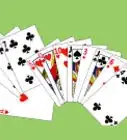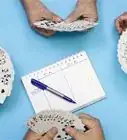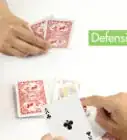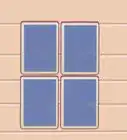wikiHow is a “wiki,” similar to Wikipedia, which means that many of our articles are co-written by multiple authors. To create this article, 49 people, some anonymous, worked to edit and improve it over time.
There are 14 references cited in this article, which can be found at the bottom of the page.
The wikiHow Video Team also followed the article's instructions and verified that they work.
This article has been viewed 740,793 times.
Learn more...
Hearts, one of the most popular, enduring card games in the world, is great fun for players of all ages, though the rules can be somewhat tricky for rookies. Also known by the names "The Dirty", "Black Lady", "Crubs", "Black Maria", and others, this game requires players to avoid acquiring certain cards (most notably, the titular Hearts) in order to win. See Step 1 below to start learning this old favorite!
Steps
Printable Rule Sheet
Understanding the Basic Rules of Hearts
-
1Grab a standard deck, a few friends, and some scratch paper. Hearts is a versatile game - it can be played by 3-7 players, though 4 is the standard number. Hearts uses a normal 52 card deck (minus Jokers).[1] Other than your cards, all you'll need is some scratch paper (or something else to write on) and a pen to record your score. Players are all dealt the same number of cards - usually by having one player deal in a circle until no cards remain.[2]
- The first dealer is either pre-determined or selected via some other method -- for example, having players draw cards at random, the lowest being the first to deal. The deal proceeds to the original dealer's left at the start of each hand.
- Note that, if you're playing with a number of people other than 4, you may have leftover cards at the end of dealing. These are called "hole" cards. Once you're sure everyone has the same number of cards, remove the leftovers from the game without looking at them and shuffle them back into the deck before the next hand.
-
2Pick up your cards, and pass three cards as follows:[3]
- First round - left
- Second round - right
- Third round - across
- Fourth round - you keep your cards
- Fifth round - left
- Sixth round - right
- Seventh round - across
Advertisement -
3Pick up the cards the opponent passed. Do not pick up the cards until everyone has passed the cards. See if you have a two of clubs (2♣), as this will start the game.[4] Play the two of clubs to start the game, and play continues clockwise.
- Hearts (♥) are worth one point, the queen of spades (Q♠) is worth thirteen points, and points are bad, like golf.
-
4Play "tricks" by attempting to "follow the suit" of the card that led. In Hearts, play proceeds in a circle, each player playing one card from his or her hand at a time, face up. The cards from one such "cycle" are called a "trick". In Hearts terminology, whoever plays the first card of a trick is said to "lead" the trick.[5] This person can play whatever card s/he wants (with exceptions - see point below). The players following this leader must play cards of the same suit as the leading card if they have them - if not, they may play cards of another suit.
- The one exception to the lead card being able to be anything is that the lead card cannot be a Heart until Hearts have been "broken". Hearts are broken when a player is unable to follow the suit of a lead card and plays a Heart instead.
-
5Avoid taking tricks by trying not to play the highest-ranking card during the trick. After all players have played a card, the highest-ranking card that matches the suit of the card that led the trick "wins" and the person who played that card takes all the cards in the trick and keeps them face down in a pile in front of him or herself until the end of the hand. Whoever wins the trick leads the next trick - play proceeds in this way until all players have no more cards in their hands. As we'll see below, usually, you don't want to win tricks.[6]
- In each suit, the cards are ranked from the Ace (the highest value) on down, with 2 being the lowest value. For example, the Ace of Clubs is the most powerful Club, followed by the King of Clubs, the Queen, and so on.
- So, for example, if the person who led the trick played a Queen of Diamonds and we have an Ace of Diamonds and a Five of Diamonds in our hand, we have to play one of these Diamonds. The Ace will win the hand for us because it's the highest card of the same suit as the lead card, while the Five won't beat the Queen. In most cases, since we usually don't want to win hands, we'll probably play the Five.
- In each suit, the cards are ranked from the Ace (the highest value) on down, with 2 being the lowest value. For example, the Ace of Clubs is the most powerful Club, followed by the King of Clubs, the Queen, and so on.
-
6Avoid Hearts and the Queen of Spades. In Hearts, like in golf, all players want to gain the lowest amount of points possible - whoever has the fewest points at the end wins. The cards that are worth points are the Hearts [worth 1 point each, regardless of value] and the Queen of Spades [worth 13 points by itself]. These are the only point cards. All other cards are worth no points, so you may collect these without fear. Since it's difficult to tell whether another player will play a Heart or the Queen of Spades after you, usually, you want to avoid taking tricks altogether, even if no point cards have been played yet.
- There is one important exception to the goal of avoiding points. If, in a given hand, a player manages to collect ALL the points from that hand (this is called "Shooting the Moon" or "Running"), s/he receives a score of 0 and all other players receive 26 points. So, if a player is losing badly and has collected every point card in the hand so far, he or she may risk an even-worse score by trying to collect every Heart and the Queen of Spades. If he or she can do it, he or she will have scored a major victory, but if one of his/her opponents gets just one of the point cards, he or she will be left with a bad score for the hand.
-
7Calculate your score at the end of each hand. When all players have played their last card, the hand is over. Players look through the cards from the tricks they took during the hand and calculate a score for the hand based on the number of point-scoring cards they took. As noted above, each Heart is worth 1 point and the Queen of Spades is worth 13 points. The players add their score from the most recent hand to their cumulative score from previous hands and, finally, the person to the left of the last dealer deals a new hand.
- Play continues in this fashion until one player reaches some agreed-upon number of points (often 100 points). When one (or more) players reach this point limit, the game stops and whichever player has the fewest points wins.
-
8Be aware of common rule variations. The rules outlined above constitute the most "basic" version of Hearts. Though these rules are accurate and perfectly acceptable for play, in reality, many variations on these standard rules exist.[7] You may or may not want to incorporate these into your game. Listed below are some of the most common rule variations.
- After being dealt cards, each player passes three cards of his choosing to another player. Usually, in a 4-person game, players pass to the player to the left at the start of the first hand, then to the right on the second hand, then across on the third, then refrain from passing on the fourth, then repeat this cycle.
- The player who is dealt the Two of Clubs (or is passed it) starts each hand, rather than the player to the left of the dealer. This player must lead with the Two of Clubs as her first play of the game.
- The "hole" cards leftover after dealing the deck out to a number of players other than 4 are given (face down) to whoever takes the first heart.
- On the first trick of each hand, no point card may be played.
- In some variations, if a player shoots the moon, he has the option to subtract 26 points from his score rather than adding 26 points to the other players'. This is a good idea if adding 26 points to everyone else's scores would put one or more players over the score limit, ending the game and causing the shooter to lose.
Learning Basic Hearts Strategy
-
1Start the game by passing your highest cards.[8] After the cards have been dealt, each player looks at their cards and then chooses three cards to pass to an opponent. When everyone has selected their three cards, everyone passes at the same time. Usually, since you want to avoid taking tricks, it's a smart idea to pass your highest-ranking cards to another player.[9] This minimizes your trick-winning potential.
- Another passing strategy is to "short-suit" yourself (see below).
- Passing direction changes every hand. On the first hand, pass to the player left of you. On the second hand, pass to the right. On the third hand, pass to the player across from you. On the fourth hand, no cards are passed. At the fifth hand, the cycle starts again.
- There may be different house rules on passing depending on where you play.
-
2Begin playing, following suit when you can. The player with the Two of Clubs must lead with this card as the first play of the game. Each player after the lead must follow suit if he can. If a player cannot follow suit (on any trick), they may play a card in any other suit. A player wins a trick when he or she plays the highest card of the suit that is led. The winner of the trick leads the next.
- On the first trick of each hand, no points (Hearts or the Queen of Spades) may be played, even by a player who can't follow suit. Such a player must play a card of a non-scoring suit.
-
3If you lead a trick, try to play a card that is likely to be beaten. It's "tricky" to have to lead a trick. Unless you're starting a hand off by leading with the Two of Clubs, most of your cards are valid possibilities, so it can be difficult to decide how to proceed. When in doubt, go low - play a low-ranking card from a suit that hasn't been played heavily in the current round. Odds are that most, if not all of the players will have cards of this suit in their hands. If you play a low-ranking card, most of the time, someone will be forced to play a card of the same suit that's higher, ensuring that you don't take the trick.[10]
- There are exceptions to this generality - for instance, if you're trying to shoot the moon, you may want to play high cards, or if you've been keeping track of the cards being played and think it's likely that everyone has at least one card of a certain suit, you may want to lead high. You also may be forced to lead high as you run out of cards.
- As noted above, you can't lead with a Heart until Hearts are broken when a player lacks a card in the suit that has been led, so he or she throws down a heart instead. As also noted above, most common Hearts variations don't allow Hearts to be broken on the first trick. The exception to these rules is when a player has voided all other suits and possesses only Hearts.
-
4If you don't lead a trick, follow suit with a card lower than the lead card. If someone else leads the trick and you have one or more cards that are the same suit as the lead card, you have to follow suit. If you can, play a card lower than the lead card so that you won't take the trick. This is especially important if other players have yet to play their cards, as you have no way of knowing whether they'll play hearts or the Queen of Spades, leaving you to pick up the points
- If you don't have cards of the same suit as the lead card, you usually want to either play a point card so that whoever wins the trick will gain points or get rid of a high-value off-suit card so that you're less likely to win tricks in the future.
-
5Try to "short-suit" yourself. Generally, it's a good idea to get rid of all of the cards of one or more suits in your hand as quickly as possible.[11] This is called "short-suiting" yourself. Once you've eliminated all the cards of one suit from your hand, you'll be able to play whatever you want when other players lead with cards of this suit. This can give you an opportunity to get rid of high-ranking cards, "dump" point cards on other players, and so on.
- One way to short-suit yourself (or, at the very least, prepare to do so) is via the "pass" at the beginning of the hand. If you have, for instance, four Clubs in your hand and you pass three to another player, you'll have only one Club left to get rid of before you're short-suited (assuming another player doesn't pass you any additional Clubs).
-
6Only try to shoot the moon when you have a reasonable chance of doing so. Shooting the moon can completely upend the dynamic of a game of Hearts, allowing you to move up several places in the rankings. However, shooting the moon is very risky, so you'll want to think carefully before you do it. Obviously, you won't want to try to shoot the moon if someone else has already gotten at least one point. You also won't want to shoot the moon if you have lots of low-ranking cards, as the likelihood that you'll be able to win every trick with such a hand is quite low. Generally, you should only try to shoot the moon when you have lots of high-ranking cards (not necessarily Hearts), especially if you're already well on your way to winning all the points in a round or most of your cards are of one suit.[12]
- Remember that if no one can follow the suit of the lead card, the player who leads wins the trick automatically. Use this to your advantage. If it seems like everyone is out of a certain suit, lead with cards of this suit, starting with your highest and working to your lowest, and you'll collect tons of points.
Community Q&A
-
QuestionCan a heart be used if the queen of spades has already been played?
 Community AnswerNo, not until a heart has been "broken" by a player discarding a heart on another player's lead.
Community AnswerNo, not until a heart has been "broken" by a player discarding a heart on another player's lead. -
QuestionWhat happens if you fail to follow suit when you can?
 Community AnswerIf you get caught by the other players during or after the hand, you get penalized by reneging and you'll get penalized 26 points.
Community AnswerIf you get caught by the other players during or after the hand, you get penalized by reneging and you'll get penalized 26 points. -
QuestionDo I have to tell the other players when I am attempting to shoot the moon?
 Community AnswerNo! It is best not to tip your hand. Hopefully, by the time other players realize you are shooting the moon, it will be too late. It is up to the players to be observant of everyone's strategy.
Community AnswerNo! It is best not to tip your hand. Hopefully, by the time other players realize you are shooting the moon, it will be too late. It is up to the players to be observant of everyone's strategy.
Warnings
- Beware of the "offender"! When a player fails to follow suit (when able) without correcting his or her own mistake is deemed "offender" and is then charged for all the hearts in that deal.⧼thumbs_response⧽
Things You'll Need
- Standard 52-card deck
- 2 to 6 players
- Paper and pen
References
- ↑ https://www.bicyclecards.com/how-to-play/hearts/
- ↑ https://www.dummies.com/games/card-games/hearts/playing-hearts-the-basic-rules/
- ↑ https://www.pagat.com/reverse/hearts.html
- ↑ https://worldofcardgames.com/hearts-card-game-rules.html
- ↑ https://worldofcardgames.com/hearts-card-game-rules.html
- ↑ https://www.dummies.com/games/card-games/hearts/how-to-score-in-a-game-of-hearts/
- ↑ https://viphearts.com/rules/
- ↑ https://worldofcardgames.com/hearts-card-game-strategy-tips.html
- ↑ https://viphearts.com/blog/advanced-strategies-in-hearts/
- ↑ https://www.dummies.com/games/card-games/hearts/playing-hearts-game-strategies/
- ↑ https://en.wikibooks.org/wiki/Card_Games/Hearts/Strategy
- ↑ https://en.wikibooks.org/wiki/Card_Games/Hearts/Strategy#Shooting_the_Moon
- ↑ https://www.trickstercards.com/home/help/HowToPlay.aspx?file=hearts-basics.html
- https://www.familyeducation.com/fun/card-games/how-play-hearts
- http://www.alanhoyle.com/hearts.html
About This Article
Hearts is a card game that's traditionally played with 4 people. The goal of the game is to have the lowest score out of all 4 players when the game ends. Hearts is played over several rounds until one player scores 100 points or higher. To start the game, first choose one player to be the dealer. Then, have the dealer deal out 13 cards to each player. Each player should organize their cards by suit, then choose 3 cards to pass to another player. On the first deal, pass the cards to the right. On the second deal, pass them to the left, and on the third deal, pass them straight across. Players don't pass any cards on the fourth deal. Whoever has the 2 of clubs goes first, and they play a card in a suit of their choice face-up. The player to their left must follow with a card in the same suit if they have one. Otherwise, they can play any card in their hand. Once everyone’s had a turn, the person who played the highest card in the suit that led wins the trick and collects all 4 cards. That player leads next. Keep in mind that a player can’t lead with a heart card until hearts have been broken. For hearts to be broken, a player must follow with a heart card because they don’t have a card in the suit that led. As you're playing, try to pass off any hearts in your hand, as well as the Queen of Spades, to the other players since you don't want to win those cards. Once all of the cards have been played, each player adds up the points in the cards they collected that round. Heart cards count as 1 point, and the Queen of Spades counts as 13 points. If a player manages to take all 13 hearts and the Queen of Spades in one hand, called "shooting the moon," they score 0 points and add 26 points to everyone else’s score. Keep playing rounds until one player scores 100 points or higher. At that point, whoever has the lowest score wins! To learn more, including helpful strategies like short-suiting and shooting the moon, scroll down.
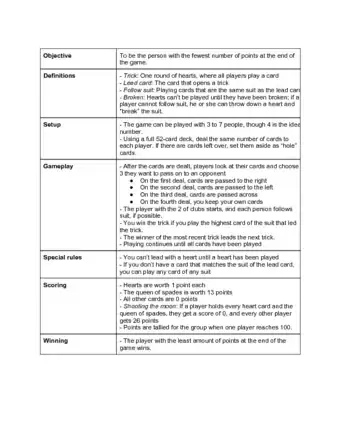

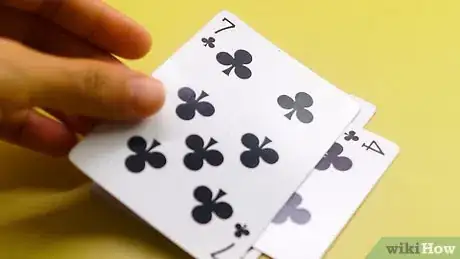
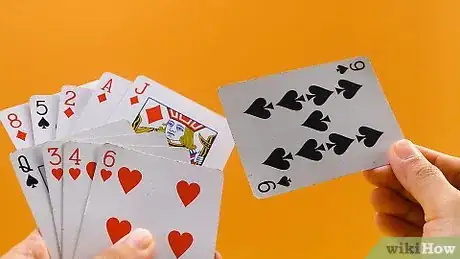
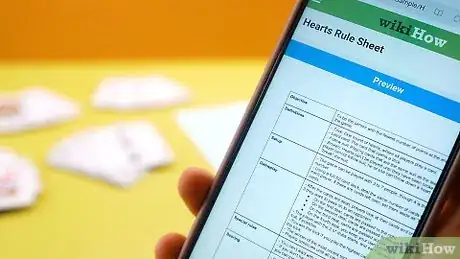
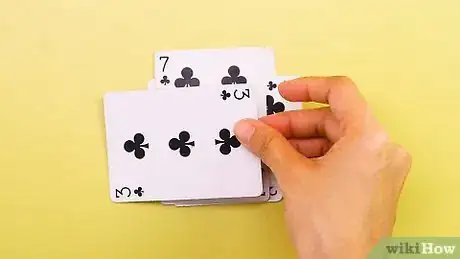

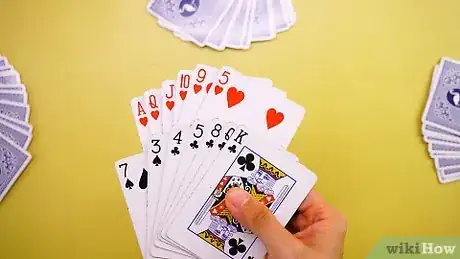
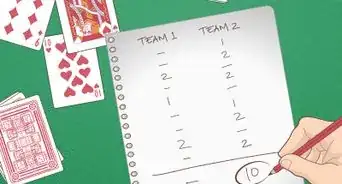
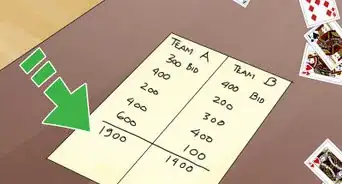


-Step-7-Version-2.webp)
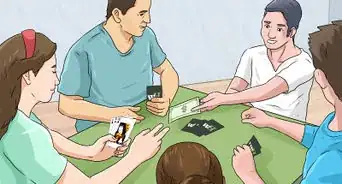
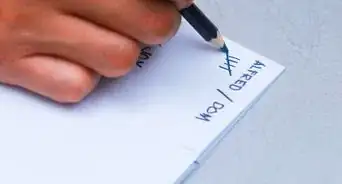
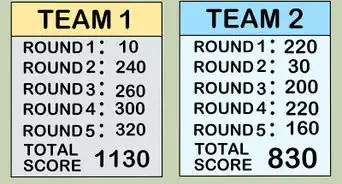

-Step-9-Version-2.webp)








